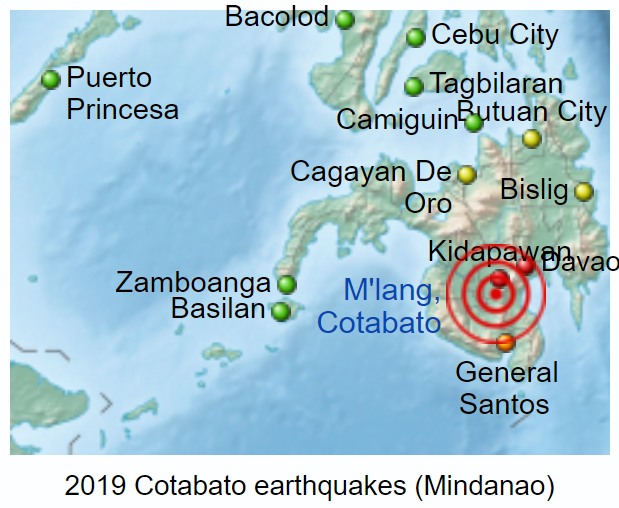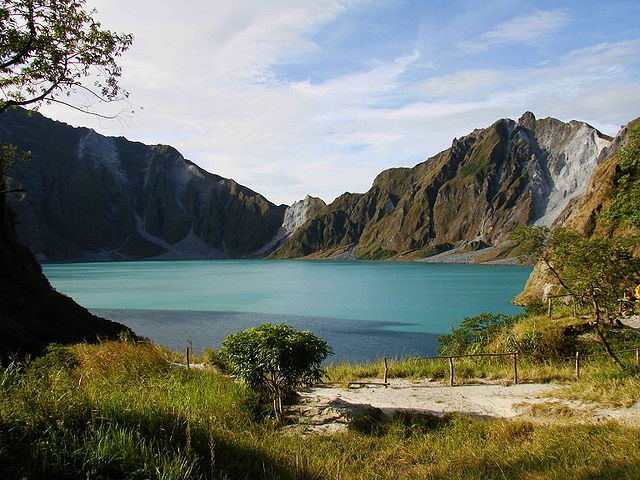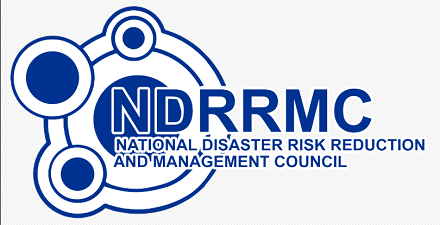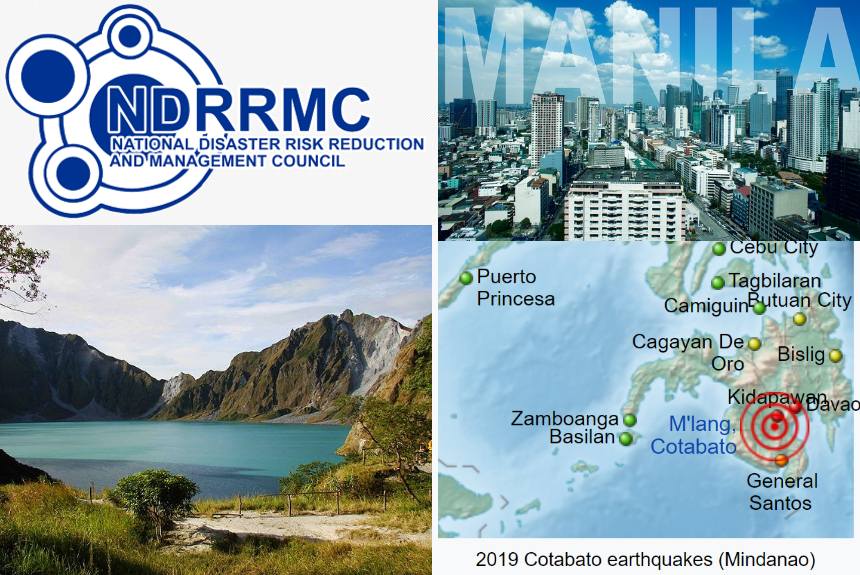To provide context on the Philippine disaster management and response, let us briefly look at the country’s population, geography, and disaster and calamity profile.
The Philippines has 108M+ people in an archipelago of 7,000+ islands
The population in the Philippines as of 2019 is 108,628,931, growing at a rate of almost 2% between 2015 to 2019 (Philippine Population 2019). It is the 13th most populated country in the world, according to the World Population Review 2019.
The Philippines is an archipelago with over 7,000 islands and a total area of 300,000 square kilometres. Most of these islands are small, with only a few large land areas like Luzon and Mindanao (World Population Review, 2019).
Manila, the capital of the Philippines, ranks 1st as the most densely populated city in the world. It has 41,515 people living in each square kilometre, followed by Mumbai at 28,508 people per square kilometre. Caloocan, another city in the Philippines, ranks 4th with 27,916 people per sq km. (Word Atlas, 2019).
A country prone to natural disasters
The article “Philippines: A country prone to natural disasters” describes how the Philippines have suffered from many deadly typhoons, earthquakes, volcano eruptions, and other natural disasters primarily because of its location close to the Ring of fire, typhoon belt in the pacific ocean region where many earthquakes and volcanic eruptions take place (Deutsche Welle, 2013).

The latest example was in October 2019, the Mindanao region, particularly the Cotabato Province, experienced an earthquake swarm, a series of strong earthquakes with three exceeding six magnitudes. Aftershocks are still being felt as of the writing of this blog post.
The quakes caused landslides and damaged infrastructure and buildings. On the 16th October earthquake, seven people died, two were reported missing, 395 were injured, and more than 2,700 houses, buildings, schools, and hospitals were damaged (Aljazeera, 2019 October). After the 29th and 31st October earthquakes, 22 people died, and 424 were further injured.
So why is the Philippines so disaster-prone?
Here are five reasons, according to the National Geographic article:
- Warm ocean waters. Because the Philippines sits just above the equator, it is surrounded by warm ocean waters at 28 degrees C. These warm waters’ powers storms’ that bring 20 typhoons a year.
- Coastal Homes. In the Philippines, 60% of the population lives along low-lying coastal areas.
- Deforestations. Bare hillsides lead to mudslides that can kill people during typhoons and clog waterways, resulting in cholera outbreaks.
- The Philippines is in the ring of fire, making it experience earthquakes and volcanic activity more frequently.
- Underdevelopment and poor population. Poor people settling in coastal areas have houses and dwellings made of flimsy materials that cannot withstand typhoons and storm surges. And inadequate evacuation plans in the Philippines also contribute to the number of people affected by these disasters.
Major disasters and calamities in the Philippines
The DW article “Philippines: A country prone to natural disasters” listed the major disasters and calamities hitting the country. In the past decade, typhoons, earthquakes, cyclones, volcanic eruptions, and other natural disasters have hit the country. The number of casualties – death and displacements, and the cost of damage (Philippines: A country, 2013).

The Relief Web, a specialised digital service of the UN Office for the Coordination of Humanitarian Affairs (OCHA), released a list of Philippines Floods and Landslide events in 2018, the number of families and people affected, and the cost of damage to the country particularly on its agriculture and infrastructure.
The UN OCHA also published a report highlighting Philippine Events in 2018, including tropical cyclones, seismic activities, volcano eruptions—particularly the Mayon Volcano eruption in January 2018—and displacements in Mindanao from natural hazards and armed conflict.
In 2018, 21 tropical cyclones and depressions entered the Philippine’s area of responsibility; eight have made landfall, and 1 of the 8 is a category 4 cyclone. A total of 5,868 seismic activities have been reported, the strongest of which was a 7.2 magnitude offshore quake in Davao Oriental on 29 December 2018, scaring the coastal communities in that region (Philippines Floods, 2019).
Managing and coping with disasters and calamities in the Philippines
How does the country manage and respond to these frequent disasters? What steps are they taking to prepare and mitigate these events?
We read an article on The Rappler, a popular online news website in the Philippines, about disaster response management, the post-disaster procedures in the Philippines, and the government departments and agencies involved.
The National Disaster Risk Reduction and Management Council (NDRRMC) is the agency in the Philippines tasked with preparing for and responding to natural calamities. It also uses strategies to mitigate the impact of disasters and increase the resiliency of the national and local governments (LGUs) in the face of disasters.”
The NDRRMC’s mitigation strategies, especially one that considers climate change and the country’s infrastructure, are included and discussed in the Philippines Disaster Management Reference Handbook, March 2018.
Who is in charge of disasters in the Philippines?

According to the Rappler article “Explainer: Who’s supposed to be in charge during disasters?” When calamity or disaster hits the Philippines, which happens quite frequently, the government’s National Disaster Response Plan under the NDRRMC is activated.
It consists of 3 stages that can sometimes overlap. Below is a summary of the stages:
The first stage is the pre-disaster risk assessment action, plants and protocol or, simply put, emergency response preparedness. Ideally, this should happen before the hazard or emergency and includes assessments of possible risks. This first stage alone involves many government departments and agencies, such as civil defence, social welfare, the Department of Interior and Local Government, and representatives from more government departments.
The second stage involves Response Clusters and Incident Management Teams (IMT). At this stage, relief and response are rallied during or after disaster hits. Again, this stage involves several government agencies and departments.
The incident management teams manage resources and personnel, while mandate and technical expertise are under the response clusters. This implies a clear and separate function for each group involved during relief and response operations.
For instance, agencies involved in the Response clusters include the Armed Forces of the Philippines, the Health Department, the Department of Social Welfare and Development, the Philippine National Police, and the Department of Foreign Affairs—in case foreign assistance is needed, among others.
The third and final stage is the Response cluster and IMT demobilisation and deactivation. This is the transition to recovery and rehabilitation, where response clusters slowly move out. Post-disaster activities happen at this stage, where response clusters review their operations and document their operations, lessons learned, and best practices to help improve policies.
Read the entire article and click the link here: Explainer: Who’s supposed to be in charge during disasters?
Reflections
From an outsider’s point of view, the sheer number of government departments and agencies involved, added to the mix by its non-governmental and religious organisation partners, looks overwhelming. We can safely assume that the Philippines has been studying and implementing best practices in disaster management.
Of course, the oversight and coordination of these various departments and agencies involved in the response and relief operation might seem like big tasks. Still, this network could have been formed due to the many years and numerous events involved in responding to disasters and calamities.
Past disasters and calamities, such as the 2013 Haiyan typhoon, have taught the people and the government many lessons about disaster preparedness and response. It is a matter of learning from these lessons.
We all agree that best disaster preparedness and emergency response planning best practices can only be most effective when applied correctly.
For additional reading on the Philippine situation, please read our previous blog post, “Is the Philippines Getting a Firm Grip on Climate Change?”
It summarises the 70-page report by the World Bank on the country’s policies and funding on climate change and its recommendation on how to implement and integrate climate actions into the country’s policies.
Sources:
Philippines Population (2019). World Population Review. Retrieved from http://worldpopulationreview.com/countries/philippines-population/
Migiro, G. (2018, November 15). The World’s Most Densely Populated Cities. Retrieved from https://www.worldatlas.com/articles/the-world-s-most-densely-populated-cities.html
Wingard, J. & Brändlin, A.S. (2013, November 10). Philippines: A country prone to natural disasters [article]. Retrieved from https://www.dw.com/en/philippines-a-country-prone-to-natural-disasters/a-17217404
Third strong quake in a month jolts Philippines’ Mindanao island (2019, October 31). Aljazeera news. Retrieved from https://www.aljazeera.com/news/2019/10/strong-quake-month-jolts-philippines-mindanao-island-191031021035036.html
Vergano, D. (2013, November 11). 5 Reasons the Philippines Is So Disaster Prone. National Geographic. Retrieved from https://www.nationalgeographic.com/news/2013/11/131111-philippines-dangers-haiyan-yolanda-death-toll-rises/
Tomacruz, S. (2018, August 14). Explainer: Who’s supposed to be in charge during disasters?. Rappler. Retrieved from https://www.rappler.com/newsbreak/iq/209482-explanation-philippine-government-disaster-emergency-response
OCHA: Philippines: Super Typhoon Mangkhut (Ompong) Impact Analysis (14 Sep 2018 0500PHT). Retrieved from https://reliefweb.int/sites/reliefweb.int/files/resources/OCHA-PHL-2018-Event-Highlights_Feb2019.pdf
Philippines: Floods and Landslides – June 2018. (2019). Retrieved from https://reliefweb.int/disaster/tc-2018-000113-phl#content_top
PHOTO CREDITS:
- 2019 Cotabato earthquakes (Mindanao) by User: Hellerick – File: Philippines location map (square).svg, CC BY-SA 3.0, Link
- Lake Pinatubo by ChrisTomnong – Own work, CC BY-SA 3.0, Link
- NDRRMC Logo by Office of Civil Defense – Based on the logo found on the official Facebook page, Link



Leave a Reply